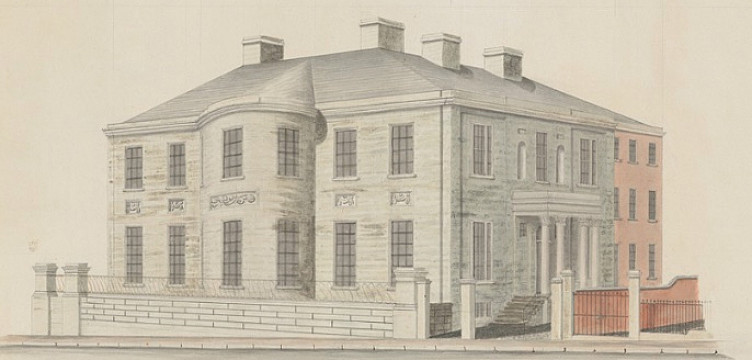David Sears House
42 Beacon Street, Boston, Massachusetts
Completed in 1822, for David Sears II (1787-1871) and his wife Miriam Clarke Mason (1789-1870). Having travelled extensively in Europe since their marriage in 1809, the Sears' returned to Boston on the death of David's father in 1816. They commissioned Alexander Parris - who by then had replaced his former employer, Charles Bulfinch, as the leading architect in Boston - to build them what would become the city's first ashlar residence. In the 1830s and 40s, Sears made extensions to the east (41 Beacon Street) and west (43 Beacon Street) to accommodate his growing family and remained here until his death. Today, all three houses are home to the Somerset Club....

This house is best associated with...
In 1816, David Sears had become the sole beneficiary to his father's $800,000 fortune which was then the largest inheritance ever received by a single individual in the history of New England. Although he dedicated himself to public life as a State Senator, abolitionist, and philanthropist, his investments saw his fortune almost double by 1855 when he was recognized as one of Massachusetts' ten pre-Civil War millionaires.
The farmland on which Sears built his home had previously belonged to the celebrated portraitist John Singleton Copley. In 1818, while living back at his childhood home at Beacon and Somerset Streets, Sears paid $20,000 for a parcel of this land that enjoyed a 90-foot frontage along Beacon Street. He knocked down the existing wooden house - Copley's studio prior to 1774 - and by 1822 had completed the house of ashlar stone seen in the picture, with the main entrance facing east. Flanking either side of the doorway were a pair of marble vases, a gift from the Empress Josephine from the Chateau de Malmaison where the Sears had been regular guests during their three years in Paris. Inside, Imperial eagles and the letter "N" reflected David's admiration for Napoleon.
In 1831, the Sears entertained two young French aristocrats, Alexis de Tocqueville and Gustave de Beaumont, who were touring America in order to learn more about democracy and equality. The latter wrote, "We dined the other day at Mr Sears'... his house is a kind of palace, he reigns there in great luxury, he treated us with splendor, I have never anywhere seen dinners more sumptuous". In 1868, the Sears held perhaps their last great social gathering when they hosted President-elect, Ulysses S. Grant, to a banquet here.
The farmland on which Sears built his home had previously belonged to the celebrated portraitist John Singleton Copley. In 1818, while living back at his childhood home at Beacon and Somerset Streets, Sears paid $20,000 for a parcel of this land that enjoyed a 90-foot frontage along Beacon Street. He knocked down the existing wooden house - Copley's studio prior to 1774 - and by 1822 had completed the house of ashlar stone seen in the picture, with the main entrance facing east. Flanking either side of the doorway were a pair of marble vases, a gift from the Empress Josephine from the Chateau de Malmaison where the Sears had been regular guests during their three years in Paris. Inside, Imperial eagles and the letter "N" reflected David's admiration for Napoleon.
In 1831, the Sears entertained two young French aristocrats, Alexis de Tocqueville and Gustave de Beaumont, who were touring America in order to learn more about democracy and equality. The latter wrote, "We dined the other day at Mr Sears'... his house is a kind of palace, he reigns there in great luxury, he treated us with splendor, I have never anywhere seen dinners more sumptuous". In 1868, the Sears held perhaps their last great social gathering when they hosted President-elect, Ulysses S. Grant, to a banquet here.
The Evolution of Numbers 41, 42 & 43 Beacon Street
In 1831, Sears purchased the adjoining lot to the west from Harrison Gray Otis and two years later (1833) built a 3-story house - also in ashlar and with a matching curved bay with saucer dome - as a wedding present for his eldest daughter, Anna, who was married that year to William Amory. At the same time, to match the new house (numbered 43 Beacon Street), Sears added a third story to his own and then - to the external eye - joined both houses together, giving the building much of its present-day appearance. The works were carried out by the original architect, Alexander Parris, again assisted by Solomon Willard who made the carved marble panels that adorn its otherwise plain exterior.
In 1835, Sears' second daughter, Harriet, married George Caspar Crowninshield and three years later (1838) he built them the - mostly - red brick mansion which adjoins his house directly to the east and is numbered 41 Beacon Street. In doing so, the original entrance to his own house was now moved onto Beacon Street, as seen today.
The Amorys lived at No. 43 for nearly twenty years before moving into No. 41 in 1852 when the Crowninshields moved to Brookline. No. 43 then became home to another daughter, Grace, who three years before (1849) had married William Cabell Rives Jr. and up until 1875 they lived between here and Cobham Park in his native Virginia.
Becoming the Somerset Club
Mrs Sears died at the end of 1870 and her husband died just four months later. In 1872, their surviving children sold Numbers 42 and 43 Beacon Street to the Somerset Club who made a series of alterations to make it suitable for club life. In 1897, the club also bought 41 Beacon Street, giving them all three of the original houses built by David Sears.
You May Also Like...
Categories
Styles
Share
Connections
Be the first to connect to this house. Connect to record your link to this house. or just to show you love it! Connect to David Sears House →


















